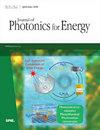Zinc sulfide-pigmented polyethylene aerogel covers for daytime radiative cooling
IF 2.1
4区 工程技术
Q4 MATERIALS SCIENCE, MULTIDISCIPLINARY
引用次数: 5
Abstract
Abstract. Optically selective and thermally insulating (OSTI) covers, such as polyethylene aerogels (PEAs), have recently been proposed to improve subambient daytime radiative cooling performance by minimizing parasitic solar absorption and heat gain at the emitter. We investigate the addition of zinc sulfide (ZnS) nanoparticles inside PEAs to improve their optical selectivity. Solving for multiple scattering effects using the radiative transfer equation and Mie theory, we model the optical properties of PEA covers with different ZnS concentrations and particle diameters. Our theoretical and experimental results show that ZnS particles inside PEAs can significantly reduce solar transmittance (<0.01) while maintaining high infrared transmittance (>0.8). Our modeling also demonstrates that ZnS-pigmented PEA covers enable higher subambient cooling powers (up to 53.8 W / m2 higher) and lower stagnation temperatures than conventional PEA under direct solar radiation (1000 W / m2). Finally, we investigate spatial distribution of ZnS within the cover and show that confining the ZnS near the air–cover boundary can reduce the total ZnS mass required by 59% or can enable 4% higher cooling power. Our findings promise to improve the performance of subambient radiative coolers and enable their application in passive cooling of buildings and refrigeration of food produce.用于日间辐射冷却的硫化锌着色聚乙烯气凝胶覆盖物
摘要光学选择性和隔热(OSTI)覆盖物,如聚乙烯气凝胶(PEA),最近被提出通过最小化发射器处的寄生太阳能吸收和热增益来改善亚环境日间辐射冷却性能。我们研究了在PEA中添加硫化锌(ZnS)纳米颗粒以提高其光学选择性。利用辐射传输方程和Mie理论求解多重散射效应,我们对不同ZnS浓度和粒径的PEA覆盖层的光学性质进行了建模。我们的理论和实验结果表明,PEA中的ZnS颗粒可以显著降低太阳透过率(0.8)。我们的模型还表明,ZnS着色的PEA覆盖物可以实现更高的亚环境冷却功率(高达53.8 W / m2更高)和比直接太阳辐射下的传统PEA更低的停滞温度(1000 W / m2)。最后,我们研究了ZnS在覆盖层内的空间分布,并表明将ZnS限制在空气-覆盖层边界附近可以将所需的总ZnS质量减少59%,或者可以使冷却功率提高4%。我们的发现有望提高亚环境辐射冷却器的性能,并使其能够应用于建筑物的被动冷却和食品冷藏。
本文章由计算机程序翻译,如有差异,请以英文原文为准。
求助全文
约1分钟内获得全文
求助全文
来源期刊

Journal of Photonics for Energy
MATERIALS SCIENCE, MULTIDISCIPLINARY-OPTICS
CiteScore
3.20
自引率
5.90%
发文量
28
审稿时长
>12 weeks
期刊介绍:
The Journal of Photonics for Energy publishes peer-reviewed papers covering fundamental and applied research areas focused on the applications of photonics for renewable energy harvesting, conversion, storage, distribution, monitoring, consumption, and efficient usage.
 求助内容:
求助内容: 应助结果提醒方式:
应助结果提醒方式:


